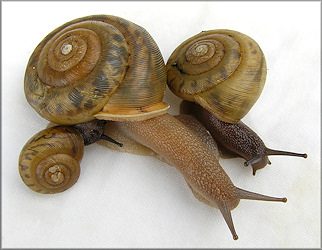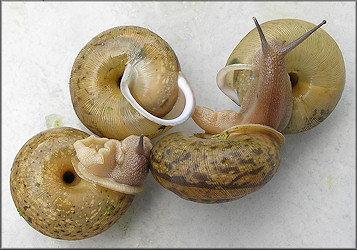Nutrition
Unfortunately there is not much knowledge about the nutrition of the Appalachina chilhoweensis specifically, but we still can look the process of nutrition acquisition of most terrestrial land snails.
The variety of terrestrial snail’s diet is fairly wide usually consisting of plants, fungi, and animal matter (Carnegie, 2009). As for the A. chilhoweensis, we know that as part of the Class Gastropoda so it is a herbivore (Hickman,2009), and that as part of the Family Polygyridae so it means that their food source is chiefly the mycelia of fungi (Pilsbry, 1940). Terrestrial snails have to take advantage of all types of food sources that are in the path of their movement due to the difficulty to travel long distances. Most of the time however, terrestrial snails are sessile and are usually only moving when looking for a food source (Hickman, 2009).
The best time for terrestrial
snail’s to be on the move looking for food is during the night time,
when the evaporation rate is lower allowing
Once food is located, a snail
will touch it with its mouth and foot which are used to “taste” the
food
source. It will then use its radula to begin rasping at the food
source to move it towards their esophagus
(Carnegie, 2009). Radula’s can vary in shape and use depending
on the type of habitats  certain snails are found in, but most
terrestrial snails have a radula with a chitin membrane that is
coarse like sandpaper for scraping at food
(Carnegie, 2009). As the food is scraped off the food
source it moves down the esophagus by muscular contractions
(Carnegie, 2009). There are saliva
glands that begin to break down the food as it moves into the
gastric pouch (Carnegie, 2009).
certain snails are found in, but most
terrestrial snails have a radula with a chitin membrane that is
coarse like sandpaper for scraping at food
(Carnegie, 2009). As the food is scraped off the food
source it moves down the esophagus by muscular contractions
(Carnegie, 2009). There are saliva
glands that begin to break down the food as it moves into the
gastric pouch (Carnegie, 2009).
The Appalachina chilhoweensis is also found among the leaf litter like common terrestrial snails due to the amount of food and protection from drying out that the leaf litter provides(Carnegie, 2009). The A. chilhoweensis use the same type of locomotion as common a terrestrial snail, which allows us to make a reasonable comparison between the common terrestrial snail’s behavior to acquire food to the A. chilhoweensis.
It would be
interesting to do further research on the A. chilhoweensis'
behavior to acquire food, because of the semi-dry air located high up
in the Appalachian Mountains. The A. chilhoweensis could
perhaps have modified mucus that dries slower and a coarser radula
to improve the efficiency of movement and eating compared to many
terrestrial snails that live in environments with more moisture.
Next we will look at the reproduction of the Appalachina chilhoweensis!!!